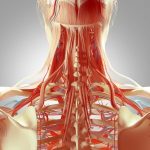Rightly or wrongly spinal manipulations and mobilisations remain a staple part of physiotherapy treatment. There are numerous complication reported from using this treatment and altered cardiac function and blood pressure is one of them. A systematic review published in the Hong Kong Journal of Physiotherapy aimed to clarify whether or not manual therapy affects cardiac function and specifically blood pressure.
Cervical Arterial Dysfunction | Roger Kerry
Methodology
PRISMA was the guideline used and the review was registered in PROSPERO, both are signs of a sound systematic review. The Cochrane Library and PubMed were the databases of choice for the search strategy, it would have been ideal to see one or two more but these a probably the bare minimum to include. The search was restricted to RCTS, English language and decent keywords using MeSH and Boolean terms and operators. Three reviewers were included which is standard practice in systematic review methodology. Articles were included if they assessed at least one cardiac parameter.
Risk of Bias and PEDRo were used to asses methodological quality of each study included within the review. After the search strategy was performed 11 studies were included within the meta-analysis.
Results and Clinical Implications
Frustratingly there are no raw blood pressure recordings to look at within the publication which makes critiquing the results difficult. It is reported within the article that there was a statistically significant reduction in systolic blood pressure when the results of the studies were pooled together. Diastolic blood pressure did not have a statistically significant reduction in pressure and the same can be said for heart rate. The physiological reduction of blood pressure can be attributed to the effect on the autonomic nervious system. Or perhaps is it just due to the patient being relaxed, who knows because the numbers aren’t published.
Commonsensically if a patient has a low systolic blood pressure before you perform the manipulation precautions need to be taken to ensure they do not have a vasovagal episode during or after the procedure. Better still if an alternative treatment option was found to begin with. What the review does not say is what velocity, site or type of manipulation or mobilisation causes the drop in blood pressure, just that there is a risk of a reduction.
Oddly the paper suggests that mobilisation or manipulations can be used as an adjunct treatment for hypertension. This is quite frankly a ludicrous statement and should not be the justification for using this treatment. Ever.
Does this systematic review corroborate with the extensive research and clinical practice of international expert Roger Kerry? Why not take his Cervical Artierial Dysfunction (CAD) course to find out.
 Cervical arterial dysfunction (CAD) is term a used in physiotherapy to cover a variety of vascular pathologies which can cause restrictions in blood flow to the brain. When assessing and treating the cervical spine, it is vital to understand diseases of the blood vessels that can present with pain and also to be able to assess the level of risk of a patient experiencing an arterial flow restriction during a physiotherapy assessment or treatment. In this course you will learn from a topic specialists how to make safe clinical decisions that take into account these very serious issues and how the related framework for clinical practice is being updated.
Cervical arterial dysfunction (CAD) is term a used in physiotherapy to cover a variety of vascular pathologies which can cause restrictions in blood flow to the brain. When assessing and treating the cervical spine, it is vital to understand diseases of the blood vessels that can present with pain and also to be able to assess the level of risk of a patient experiencing an arterial flow restriction during a physiotherapy assessment or treatment. In this course you will learn from a topic specialists how to make safe clinical decisions that take into account these very serious issues and how the related framework for clinical practice is being updated.